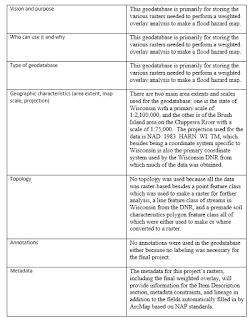Goal and Background:
The goal of this lab was to review the basics of the ArcGIS software including managing data, identifying characteristics of shapefiles, and making a basic map. ArcGIS is a software program developed by ESRI to utilize geographic data and be able to ascertain relationships among data that could not be discovered otherwise. First, basic concepts of ArcMap and ArcCatalog were reviewed. Then, functions of both software programs, including the identify function, attribute tables, and query. Finally, two complete maps were created including north arrow, legend, title, and scale bar.Methods:
To determine the geographic coordinate system (GCS), projection coordinate system (PCS), and projection of the street shapefile, the properties tab was opened and from the XY Coordinate System tab the information was recorded. Using information from the ArcGIS help window, details of ArcCatalog and key differences between ArcCatalog and ArcMap were recorded for clarity purposes. Next, the attribute table for the donut shops layer was opened to record the different attributes associated with it. Using a simple query for highways, the names of the two major highways, state highway 30 and 38 were recorded as well. By opening each layer's attribute tables, the one with the most attribute fields was recorded. Finally, two different maps were created by taking an attribute of the Erie county census tracts and symbolizing both median rent and median year the houses were built with graduating color categories. A north arrow, scale, title, and legend were added as well.Results:
After completion of the lab, concepts of ArcGIS were refreshed and solidified to provide a good base for future studies in GIS. In the map of median rent, the medium-sized sections surrounding the concentration of smaller census tracts in a crescent shape have a higher rent than those outside of it or in the small areas. The cheapest areas to rent are the small tracts in the northwest corner of the map with moderate rent rates between the cheap area and the most expensive area and outside the most expensive area.In the map of median year of house construction, the oldest buildings are located in the conglomeration of small census tracts with most falling between 1939-1941. Outside of that small concentration, there is a mixture of median years dating 1948 and beyond. There are some smaller census tracts scattered among the larger ones that have a median year built age similar to the smaller concentration as well.
1. Both of these variables relate to the housing market in this area. the tracts with the oldest houses have the lowest rent, and the areas with newer construction have higher rent. While the median rent map shows a more consistent pattern of rent groups, the median year map shows more of a mixture of categories outside of the small concentration of older houses.



